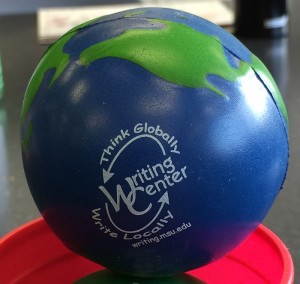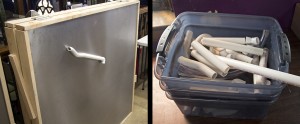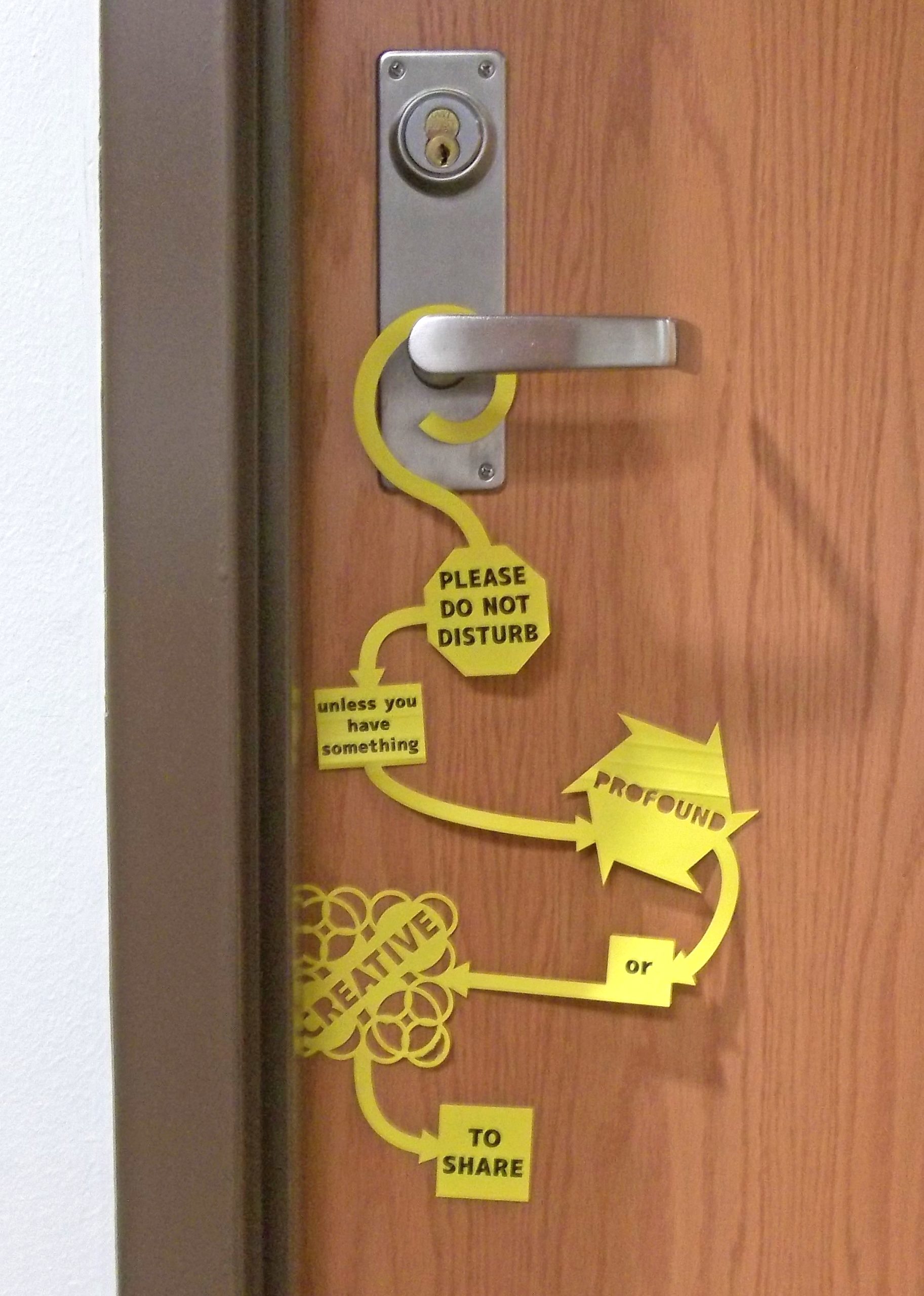A Maker Mentality Toward Writing
David M Sheridan
Elizabeth Wardle (2012) relates this example of a rhetorical intervention devised by her students:
[S]tudents in my “Medical Writing” class were asked to consider a public health problem and mount a campaign to address it. One group found that students were drinking and driving late at night to find food. As a result, they mounted a “Don’t Drink and Drive Through” campaign that entailed doorknob hangers with the phone numbers of restaurants that delivered after midnight. There were many possible responses to this problem, and they creatively explored many of them before settling on this one—which also required them to modify a text type (the sales doorknob hanger) that they had all seen but never composed themselves.
I agree with Wardle that this represents a creative answer to a rhetorical exigency. As Wardle notes, a number of rhetorical responses are possible here. We could imagine a campaign that relies on other rhetorical forms: videos, social media, infographics, and so on. But there is something compelling about the doorknob hanger. It’s simple. It’s cheap. It’s nearly impossible to ignore. Designed right, the bulk of the hanger’s message might be communicated in the seconds that are required to remove the hanger from the knob. Unlike a poster or a video, it has the ability to place itself in your hands.
Doorknob hangers are relatively simple deliverables, but they introduce considerations that are absent or less apparent in much school-based writing, which is often aimed at rectilinear surfaces: sheets of paper, computer screens, devices. A doorknob hanger, however, has a customized shape that includes a hook or a hole, enabling it to hang from a door.
The design of the hanger reflects other material concerns as well. If the paper were too thin, the hanger would deform and/or tear. Hangers destined for exterior doors should be heavy enough to withstand wind and weather.
Finally, a doorknob hanger is meant to articulate with the target material context in a specific way: it is intended to hang from doorknobs.
* * *

Here’s another example: The MSU Writing Center hands out stress balls: small foam globes that are covered with the world’s continents and inscribed with an adaptation of the Center’s logo that includes the phrase “Think Globally, Write Locally.” In a sense, this is a business card — a micro composition, containing the minimum information necessary for someone to know what an organization does and how to contact it.
But it is clear that there is additional meaning derived from the shape and structure of the Center’s stress ball. As a globe, this composition reinforces the “Think Globally, Write Locally” slogan, while simultaneously providing an image that will potentially be welcoming to MSU’s sizable population of international students, who are particularly heavy users of the Center. The foam material invites de-stressing squeezes, conveying the message that the Center can alleviate some of the stress related to writing. The ball is fun to toss around, and, because it’s made of foam, it can be thrown indoors without breaking things or hurting people. The ball thus metonymically associates the Writing Center with fun and play.
Words are a part of this message, but they are integrated into a design that employs shape, texture, and other considerations of fabrication. Suddenly, the vocabulary of materials science feels relevant as we think about the role that relative “elasticity,” “flexibility,” and “compressive strength,” play in enabling the meaning of this composition. The ball is tactile and kinetic: you pick it up, toss it around, bounce it against the wall.
As I visit makerspaces, I am encountering compositions like the doorknob hanger and the Writing Center’s foam globe that derive meaning from the complex interaction between words, shape, dimensionality, and materials. Moreover, I am noticing that, like door hangers and stress balls, maker compositions often adopt designs that anticipate certain interactions with a target physical environment.
* * *
I should say that I believe all items generated by makerspaces perform rhetorical work; words are not required for this. For instance, the Lansing Makers Network has designed a series of parts from plastic pipe, including many different shapes. Each part has magnets on one side, which means users can attach them to metal panels and create various arrangements with them. When kids visit the makerspace, they are invited to participate in a game: arrange these parts to create a maze through which a marble can travel. The person whose marble stays moving the longest wins.
This game does not contain any words, but surely it has meaning. And it’s difficult for me to imagine meaning without rhetorical weight. Viewed as a composition, this game may not form a logical argument or arrive at a specific conclusion; but it is a celebration of creativity, play, and the exploration of fundamental laws of physics (gravity, mass, momentum, velocity), etc. It is epideictic.

* * *
While all maker designs are rhetorical, in this blog post I am emphasizing maker designs that integrate alphabetic text in some nontrivial way. I see this as one of many ways to bridge the work of writing studies and makerspaces. I want to raise the idea that maker designs for writing constitute a special set of “documents.” Here I am taking a cue from Charles Kostelnick (1996), who draws our attention to the “supra textual” features of documents that are often overlooked. Kostelnick writes that
We may not even think of some supra-textual elements in rhetorical terms since they are so obvious — the cover of a report, the size and texture of the paper, section headings, page headers and footers, the arrangement of illustrations in the text. Since some supra-textual elements involve nitty, gritty “production” matters — page color, tabs, binding, and the like — they can easily be dismissed as unimportant or peripheral. However, our perception of a document begins with these elements . . . . (9)
Makerspaces expand the set of “nitty gritty ‘production’ matters” available to rhetors, resulting in new kinds of documents with new ways of enacting rhetoricity. Makerspaces introduce a different set of tools for manipulating the material form of compositions, including hammers, bandsaws, laser cutters, 3D printers, drill presses, kilns, and more. Makerspaces frequently contain raw materials — sheets of metal, bolts of fabric, and different forms of wood — that are different from what we might think of as standard writing materials. Most importantly, at makerspaces you often encounter people who have experience using these tools and materials, people who know why you would choose plywood over solid wood for a particular job, or why you would use a laser cutter instead of CNC router.
* * *

Stress balls, like mugs, bumper stickers, and t-shirts, are a standardized consumer product. The physical particularities of the object are largely pre-determined, but individuals and organizations can add customized visual content, including writing. If you’re interested in the rhetorical power of this assemblage of conditions, take a look at Jenny Edbauer’s (2005) account of Keep Austin Weird. A simple bumper sticker seems to have blossomed into a kind of movement.
But makerspaces offer a degree of freedom from the constraints of standardization. What if I want something more intricate than the standard doorknob-hanger template my local printer uses? Common makerspace technologies, such as a digital paper cutter, allow newfound flexibility, partly because they begin with a digital design that is easily manipulated before any physical manufacturing takes place.
* * *
Here are some examples of makerspace-sponsored documents:
- A book that integrates graphite circuits to accommodate multimedia and interactivity.
- A Michigan-themed alphabet book that incorporates cutouts of Michigan on each page.
- Sunglasses made out of wood from Detroit homes slated for demolition; each frame is stamped with the address of the home from which the wood was taken.
- A series of flyers for a student event that were translated into a hologram.
Processes of rhetorical invention are cognitive, but they are also social and material. Composers are embedded within the networks of tools, raw materials, spaces, media, and people; these networks profoundly shape rhetorical practices. Makerspaces introduce differently configured social-material networks, resulting in new inventional processes and new forms of composing. I am suggesting that shape, dimensionality, materials properties, and interaction with physical contexts are some of the features that a maker mentality toward writing will exploit.
References
Edbauer, Jenny. (2005). Unframing models of public distribution: From rhetorical situation to rhetorical ecologies. Rhetoric Society Quarterly 35(4), 5-24.
Kostelnick, Charles. (1996). Supra-textual design: The visual rhetoric of whole documents. Technical Communication Quarterly 5(1), 9-33.
Wardle, Elizabeth. (2012). Creative repurposing for expansive learning: Considering “problem-exploring” and “answer-getting” dispositions in individuals and fields. Composition Forum 26.
